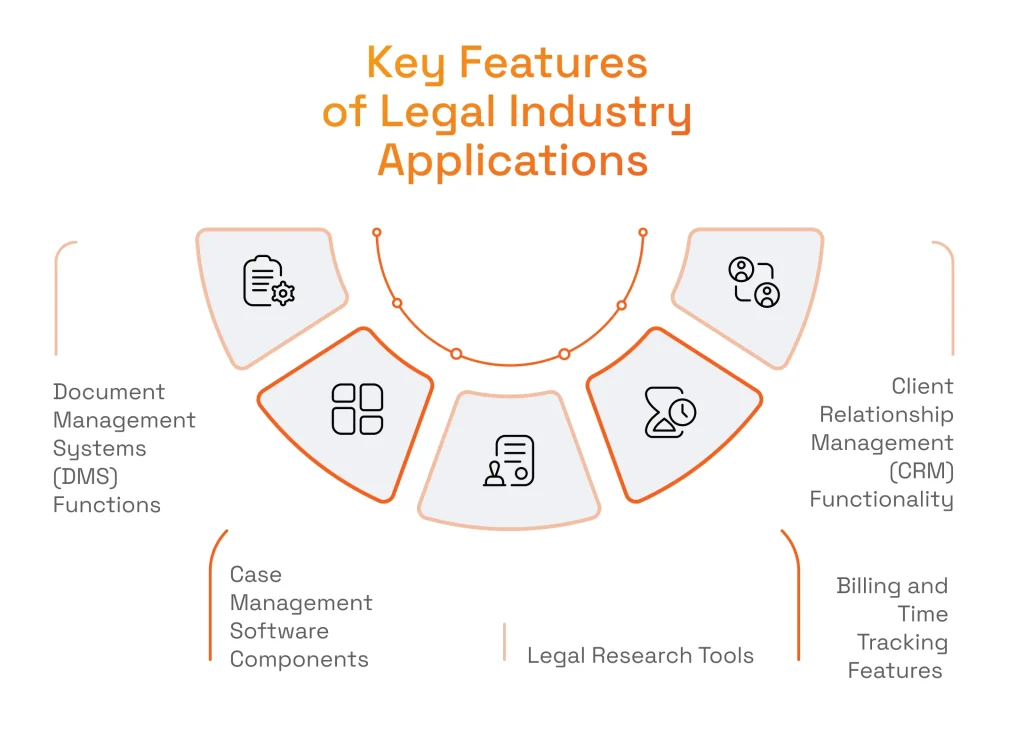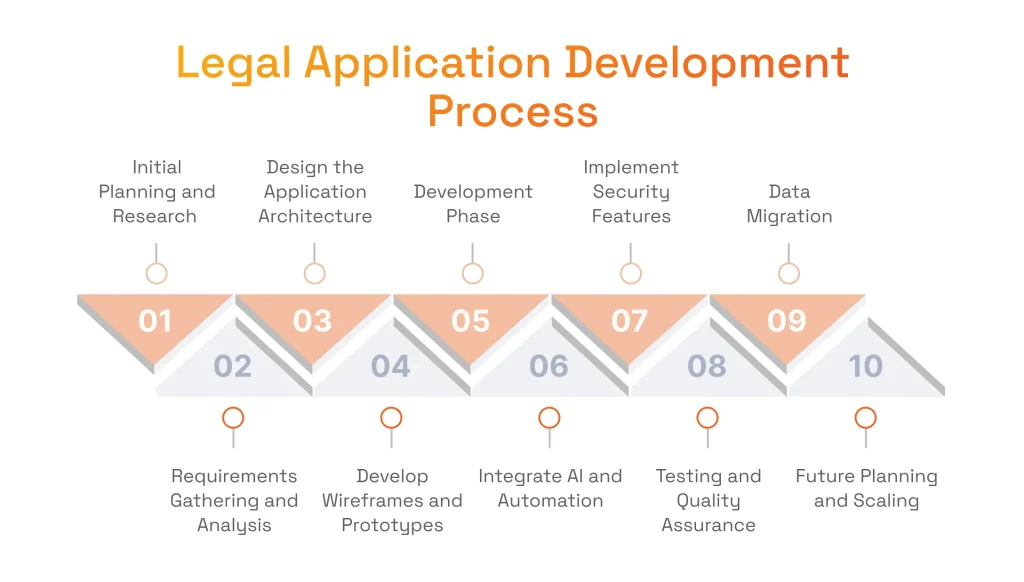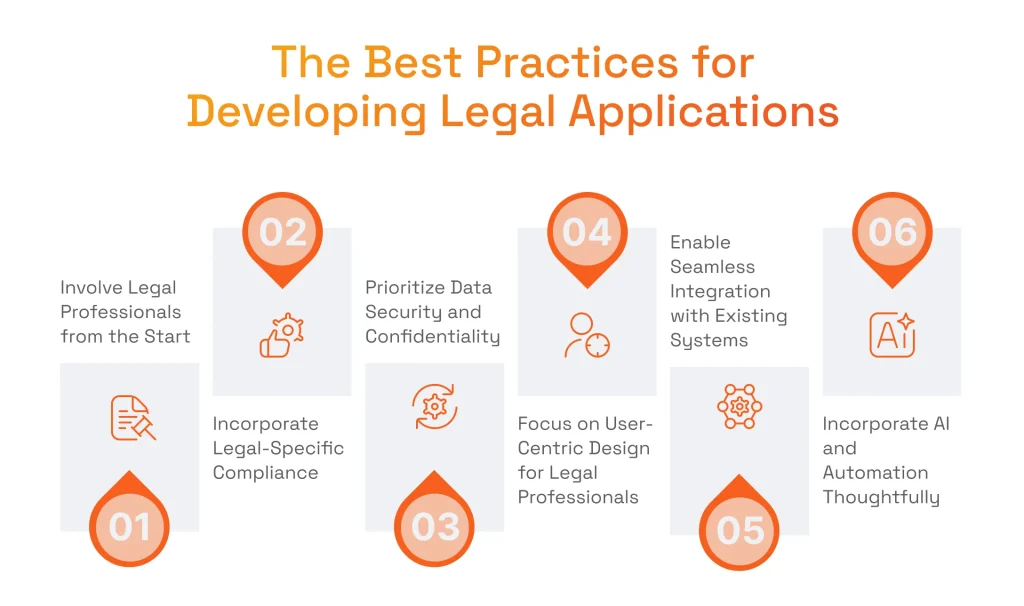The legal industry is characterized by intricate processes and a wide range of functions. Law professionals handle case, document, as well as contract management and billing, while the list of daily legal tasks can go on. One of the things powerful enough to facilitate juggling a multitude of responsibilities is a robust software platform that accommodates unique legal operations.
Software for legal sector has been a huge deal in recent years. According to Statista, the global LegalTech market surged to $27.6 billion in 2021 and is projected to expand at a CAGR of over 4% until 2027, reaching $35.6 billion. This growth reflects a significant shift towards digital transformation, with a rapidly growing market for legal technology solutions. The expansion of the market is also driving demand for applications and software solutions to meet the evolving needs of legal professionals. However, the legal industry faces many roadblocks to innovation due to its highly regulated nature. Additionally, the growth rates of smartphone app downloads underscore the increasing reliance on these applications in the legal sector.
So let’s see what specific workload issues legal software can solve and how to approach application development for lawyers.
The Importance of Application Development in the Legal Industry
Tons of legal documents requiring organizing, storing, and managing – this is what makes legal professionals sweat. The business impact of Big Data in this domain has proved to be beneficial yet causing some new challenges. It has become a major task to efficiently navigate the vast amounts of data and derive meaningful findings from it. Lawyer consulting app development paves the way to better data handling, employee productivity, and customer satisfaction. Attorneys benefit from legal technology solutions that help manage workflows, court schedules, and communication, leading to greater efficiency and compliance.

The benefits of legal software are as follows:
- Enhanced efficiency and productivity: Apps for law firms automate routine tasks. This entails the improvement of existing workflows, including case and document management, legal research, and invoice generation. Once companies are equipped with law firm productivity apps, they achieve the elimination of manual labor. As a result, legal processes become fast and error-free. Moreover, legal practitioners gain the possibility to focus more on the work that requires more intellectual effort for developing strategies. Traditional legal tasks such as case research and document review were time-consuming, but software solutions with essential features in apps now automate these processes.
- Improved client service and accessibility: Legal technology facilitates providing effective customer care. Applications for legal services can help deliver services with considerations of accessibility, quicker response times, and better communication. Mobile app development services can be beneficial here as well, as law companies can ensure their customers stay in touch with their legal team in mobile applications. At the same time, online document sharing systems and client portals improve customer interactions and build closer bonds. Such software can also assist businesses in better managing their caseloads, guaranteeing timely updates and progress reports. Mobile technology and mobile devices further enhance client experience by improving communication and overall service quality.
- Ensured compliance and security: The legal sector is subjected to many regulations. Legal software can automate tasks related to compliance, including security and data protection. Moreover, businesses can reduce legal risks and gain clients’ trust by investing in law firm app development since such software has security measures necessary to guard private client data and minimize the chances of cyber attacks.
Mobile apps enable lawyers and legal professionals to manage their calendars, track billable hours, and collaborate with colleagues directly from their smartphones. Successful legal tech apps automate tedious tasks, improve client-attorney communication, and streamline workflows.
Would you like to delve deeper into the benefits of legal technology and law firm mobile app development?
Check them in our article!
Key Features of Legal Industry Applications
The on-point functionality of applications for legal practices is the foundation for effective work of law corporations. When developing app development for legal industry, it is crucial to focus on essential features that help law offices streamline operations and enable workflow automation, such as secure document management, case tracking, and efficient client communication. Integrating with other apps and web apps is also important to enhance research, client communication, and practice management. Additionally, legal applications should integrate with commonly used tools such as email and calendars to create a unified workspace.
In this section, we review existing sets of features that legal firms can develop. You can check them and align with your business key objectives to further create a custom application with a specific toolset.

Document Management Systems (DMS) Functions
The benefits of a document management system for the legal sector is hard to deny: the software serves as a centralized hub for organizing each and every piece of information. Lawyers store legal documents there, navigate them with just a few clicks, and, what’s important, keep them secure. Document management system requirements may vary depending on the unique processes the organization follows. However, from our experience we can tell that DMS development services usually focus on the following features:
- Centralized Storage: A repository for storing and retrieving all the legal files.
- Version Control: An option for revisiting versions of documents and reverting to previous ones.
- Search and Retrieval: A feature for quick finding of documents based on keywords, tags, or metadata.
- Security and Permissions: Encryption, password protection, and user-specific access controls to protect client data and safeguard sensitive legal information.
- Collaboration Tools: Real-time editing, commenting, document sharing, etc.
Interested in the details on how to create a document management system?
Learn all the vital development steps in our guide!
Case Management Software Components
Since cases are the basic elements of any legal practice, a tool that helps organize and track the progress of proceedings is a must. Case management software allows minimizing mistakes, distributing tasks, keeping the workflow updated, and checking case progress. The following features combined makes a solid application for case management:
- Case Tracking: A tool for assessing case performance and not missing deadlines and milestones.
- Task Management: A hub for distributing tasks among employees and monitoring their completion.
- Document Integration: A system that allows easy access to case-related documents.
- Calendaring: Features that keep track and remind about court appearances, filing deadlines, and meetings.
- Reporting: A toolset for generating reports about case progress and workload distribution.
Modern case management systems can also integrate with legal chatbots and virtual legal assistants to provide instant client support, legal advice, and task automation, further streamlining workflows and case handling.
Legal Research Tools
Legal firms need to have access to current and correct legal information. Tools for research give lawyers the legal resources they need to present accurate arguments and handle client representation skillfully. Legal expertise is essential in developing and maintaining advanced research tools to ensure their accuracy and compliance with industry standards.
- Comprehensive Databases: An access to legal databases, including statutes, case law, regulations, and legal journals.
- Citation Management: Tools for making sure that legal professionals accurately cite sources and keep track of references.
- Annotations and Notes: Features that allow annotating legal documents and adding personal notes facilitate analysis.
- Updates and Alerts: Features that provide updates and alerts on changes in laws or new case rulings.

Artem Dyranov
Business Analyst at SPD Technology
“Legal research tools benefit from advanced search functionalities, especially when enhanced with natural language processing (NLP), because NLP allows users to perform more intuitive and accurate searches. This technology understands and processes queries in natural, everyday language, enabling it to interpret the intent behind complex legal questions.”
Billing and Time Tracking Features
When it comes to law company profitability, it is essential to establish solid time tracking and billing processes. A specialized software can assist in these tasks and automate a plethora of routine procedures to reduce errors and improve cash flow. For that, apps for law firms need to have the following functionality:
- Time Entry: A tool for logging billable hours through automated timers or manually.
- Expense Tracking: A functionality for tracking of expenses, such as filing fees or travel costs.
- Invoice Generation: A process based on time entries and expenses for billing.
- Financial Reporting: A tool that generates financial reports and analytics for financial management and accounting.
Client Relationship Management (CRM) Functionality
A CRM system allows fostering a strong partnership between clients and law firms. It provides the ability to manage client information, track interactions, reach out to customers, and more. Moreover, the system keeps all the client information in a single place, ensuring that lawyers can craft personalized services for their clients. The following features are crucial for a full-fledged CRM:
- Contact Management: A functionality for keeping contact details, case history, and communication records.
- Communication Tracking: Tools for tracking communications and documenting interactions.
- Client Portal: A hub for secure communication between clients and legal practitioners about case updates, documents, and other matters.
- Marketing and Outreach: A system for managing campaigns, tracking leads, and analyzing acquisition and retention metrics.
- Client Satisfaction: Tools for gathering and analyzing user feedback to maintain strong client relationships.
The Step-by-Step Process of Application Development for the Legal Industry
If you are interested in law firm app development, start by learning the breakdown of the process. Application development for the legal industry is crucial for effectively dealing with legal matters, client communication, and legal outcomes. We offer an overview of the main stages.

Initial Planning and Research
The development process requires a thorough groundwork. This is why, the first thing developers and project managers do to build apps for legal teams is clearly defining the problems the application will solve. IT specialists take into account the features the app needs to allow the law firm to achieve its goals. They also identify market trends and analyze competitors to offer a relatively new solution to potential clients and have opportunities for innovation.
Another important factor to consider is regulatory requirements and ethical considerations. To safeguard the company and its clients, industry-specific standards must be followed when creating an application for law services. The future system must also incorporate features like secure communication channels and access controls in order to comply with the ethical requirements of legal professionals.
Requirements Gathering and Analysis
Detailed documentation with all the requirements is crucial at this stage. According to Wellingtone, around 60% of projects have a scoping document before they are started. It results in a more fruitful cooperation. Therefore, clear, detailed requirements must be established, covering everything from performance benchmarks to security protocols, compliance standards, and scalability goals.
We know for a fact that initial planning increases the chances of a successful outcome. One of our projects involved transforming a legacy notary service into a full-fledged legal solution. When we embarked on the project, it lacked any documentation. However, our project manager created a 400+ page document and maintained it throughout the project lifecycle. By having all processes documented, we successfully delivered a fully functional cloud-based product that expanded the client’s business reach to 20 US states.
Design the Application Architecture
Choosing the right architecture for law firm app development contributes to ensuring scalability and flexibility. Some of the most common options are modular, microservices, or cloud-based architecture. The choice in favor of one or another type can be based on preferred functions of the app. For example:
- Modular architecture allows independent updates to components like case management or billing.
- Microservices enable scalable, loosely coupled services ideal for complex legal functions.
- Cloud-based architecture offers dynamic scaling and remote access, enhancing collaboration and performance.
For enterprise clients, robust security controls, compliance with regulations, and reliable API integrations are critical. Legal applications must implement strong enterprise-level security measures, including data encryption and secure authentication, to ensure confidentiality and system integrity.
The size and complexity of the law firm, the type of legal services offered, the budget and resources, as well as the firm’s growth objectives also influence the selection of architectural design for an app.
Develop Wireframes and Prototypes
The last step before starting an actual development process requires creating wireframes. They provide a visual depiction of how users will interact with the system and act as a blueprint for the application’s user interface. They are also essential to making sure the legal services app is user-friendly and meets user expectations.
Once wireframes are ready, they are used to make a clickable prototype. This step allows you to interact with a preliminary version of the software and provide feedback for your development team. Thus, you ensure that the design of the future app can be refined before moving into full-scale development.
Development Phase
Finally, after all the preliminary work, you and your development team can start building the application. Custom software solutions are developed at this stage to enhance the efficiency and capabilities of law firms, addressing specific needs such as practice management, litigation support, and workflow automation. This stage is conventionally divided into two parts: backend and frontend app development for legal industry.
Develop the Backend
The backend handles the application’s core operations. When developing it, software engineers work on several main components. Some of them include:
- Server infrastructure as it manages user requests, handles data, and provides the required outputs.
- Databases as they store and fetch client records, files on cases, and data on financial transactions.
- API endpoints as they guarantee the interconnection between all the internal components and external systems.
Moreover, the backend tackles all the app’s logic and manages all the necessary functionality. For law practice management apps, the backend usually includes features like case management, where end-users can track case progress, manage schedules, and store important documents. Other features can be document handling for the secure storage, retrieval, and sharing of legal documents, and billing functionality for time tracking, invoicing, and payment processing.
Develop the Frontend
The frontend serves as a touchpoint with the app. Designers and developers create intuitive, user-friendly, and trendy user interfaces. During this development stage, your IT team will rely on previously created wireframes and a prototype to accurately recreate the app’s planned look and feel.
Another crucial point for the frontend is responsiveness. The app will better serve its purpose if the users can work with it on different devices and, respectively, screen sizes. Performance and accessibility are also major priorities for a well-designed frontend: it should load rapidly and with little lag, even when the tasks get more complex. Thus, the app ensures an uninterrupted work of law firms.
Integrate AI and Automation
AI/ML solutions development can aid with automation of multiple legal processes. By taking care of repetitive tasks like time monitoring and document generation, it will greatly increase productivity by guaranteeing consistency and minimizing manual labor. Another must-have AI-powered feature for legal practice is predictive analytics. By predicting case outcomes, predictive analytics provides data-driven insights to inform legal strategies.
AI-powered analytics platforms can analyze vast timecard data to help firms accurately predict litigation support costs. Predictive analytics can also estimate the likelihood of winning a case by analyzing previous rulings and judge behaviors. AI-powered contract lifecycle management systems automate drafting, clause detection, and approval workflows. AI tools can monitor changes in regulations and alert legal teams instantly. Automation in legal AI applications can handle tasks like form generation, filing, and client intake, reducing overhead for repeat tasks. Legal AI applications can provide 24/7 support through chatbots, integrating with case management systems and CRM tools. AI can significantly reduce the time required for legal research by providing answers in seconds instead of days. Legal AI applications can automate compliance tracking and generate compliance reports to minimize risk exposure.
Generative AI gains popularity for legal application development as well. According to Gartner, large language models are poised to supercharge legal department efficiency by 10% to 20% in the next two to five years. Leveraging generative AI development expertise for integrating intelligent processes into an app for law services can significantly accelerate legal research. Ethical AI use is essential, ensuring that AI complements lawyer judgment and is thoroughly vetted. Legal expertise is crucial in developing and maintaining AI-powered legal applications to ensure compliance, security, and effective integration.
Litigation support software and services, such as Briefpoint, automate preparing discovery responses using AI, saving significant time during litigation. TrialPad is an iPad app that assists lawyers with organizing and annotating documents for courtroom presentations. Online Dispute Resolution (ODR) platforms provide secure virtual environments for mediation and arbitration. Rocket Lawyer is a platform that connects clients with lawyers and provides features for legal advice and document creation.
As a part of our experience in using the latest AI advancements for legaltech, we helped our client, Legal Shelf, integrate AI for advanced document search functionality and optimized document processing of 30,000 documents. By leveraging our proficiency with AI/ML, we automated the extraction of important data from legal documents with precision, including information on participants, expiration dates, contract durations, entity relations, document subtypes, and renewal options.
Implement Security Features
Safeguarding sensitive data, such as customer information and case details, is necessary in the legal landscape. Strong security measures are required by clients and regulations to ward off cyber attacks, breaches, and unwanted access. Key security measures that must be taken into account during development are:
- End-to-end encryption, which ensures data is securely transmitted and stored, preventing unauthorized interception.
- Role-based access control, which restricts access to data based on user roles, minimizing exposure risks.
- Audit logging, which tracks all actions within the application, aiding in security monitoring and compliance.
Conducting routine security audits and vulnerability assessments is also essential for preserving defense against dynamic attacks. Once you have these security measures in place, your legal application is solid for guaranteeing the respect of client confidentiality, safeguarding private data, and adhering to strict data protection regulations.
Testing and Quality Assurance
Testing makes sure that law practice management apps work as intended, has all the functionality required by the legal firm, and is reliable. At this stage, individual parts and their integration into the system are subjected to quality assurance. In such a way, QA engineers ensure that all the app’s components function in accordance with each other.
It is also necessary to conduct performance testing and evaluate how the application functions under multiple user loads and stress scenarios. This type of testing uncovers potential bottlenecks, guarantees consistent responsiveness and dependability, and makes sure the software can withstand demands from the real world without experiencing performance deterioration.
Data Migration
Data migration is another critical phase, involving the careful transfer of legal data from existing systems to the newly-built application. Preserving data integrity during this process is vital for ensuring continuity and preventing data loss. A smooth data migration ensures that the transition to the new system is seamless, with all necessary information accurately carried over, minimizing disruption to ongoing operations.
Future Planning and Scaling
This final yet ongoing stage involves continuously assessing the performance of law practice management apps as they gain users and need to manage increasing amounts of data. It is critical to make sure the program stays responsive and provides all the necessary functionality as usage increases. In order to manage the increased demand, upgrading the infrastructure can become a pressing matter along with design optimization. Planning such reworks ahead guarantees that the software can grow in the future without compromising functionality.

Artem Dyranov
Business Analyst at SPD Technology
“The tech landscape is constantly evolving, and staying informed about emerging technologies, such as blockchain and advanced AI, ensures that the application remains competitive and capable of integrating new features that enhance its functionality.”
Cost of Developing Legal Apps
The cost of developing apps varies significantly based on the app’s complexity, web and mobile technology stack, and the expertise of the development team. For law firms and legal professionals considering app development, a basic legal app typically starts at around $25,000, while more advanced software solutions with custom functionality, integrations, and strong security features can exceed $250,000.
The development process includes several stages: initial research, design, development, testing, and deployment. Each phase contributes to the overall cost, but also ensures the app is tailored to the unique needs of the legal industry. Investing in experienced app development teams is crucial, as they understand the nuances of legal workflows, compliance requirements, and client communication standards.
While the upfront investment may seem substantial, the long-term benefits—such as increased efficiency, improved communication with clients, and enhanced case management—can deliver a strong return on investment. Modern apps also help law firms stay ahead of competitors by offering innovative technology software solutions that attract and retain clients. When budgeting for app development, it’s important to weigh both the immediate costs and the strategic advantages that a well-designed app can bring to your law firm.
Launch and Marketing
Successfully launching and marketing a legal app requires a well-planned strategy tailored to the needs of the legal industry. Law firms and legal experts should start by clearly identifying their target audience—whether it’s other legal specialists, clients, or the broader public—and designing the app to address their specific needs and preferences.
A comprehensive marketing plan is essential. This should include leveraging digital channels such as social media marketing, content marketing, and targeted paid advertising to reach potential users. Listing the app in the Apple App Store and other major app stores is crucial for visibility and accessibility, ensuring clients and professionals can easily find and download the app.
Law firms should also utilize their existing networks, including their website, newsletters, and social media platforms, to promote the app and highlight its key features. Throughout the launch and marketing process, it’s vital to maintain compliance with legal industry regulations and standards, ensuring the app is secure, reliable, and trustworthy. By executing a thoughtful launch and marketing strategy, law firms and professionals can boost their online presence, enhance communication, and strengthen their reputation within the legal sector.
Post-Launch Review and Evaluation
After launching a legal app, ongoing review and evaluation are essential to ensure it continues to meet the needs of law firms, professionals, and clients. Gathering user feedback through surveys, app store reviews, and focus groups provides valuable insights into how the app is performing and where improvements can be made.
Monitoring key performance indicators—such as download rates, user engagement, and retention—helps law firms assess the app’s impact and identify trends in user behavior. It’s also important to track the app’s return on investment, including any increases in revenue, efficiency, or client satisfaction resulting from its use.
Regularly updating the app based on user feedback and performance data ensures it remains relevant and effective in the ever-evolving legal industry. This continuous review process not only helps maintain a high level of service for clients but also uncovers new opportunities for growth, such as adding new features or expanding the app’s capabilities. By prioritizing post-launch evaluation, law firms and legal experts can ensure their apps remain valuable tools for both their teams and their clients.
Continuous Improvement and Updates
Continuous improvement and regular updates are non-negotiable for legal apps aiming to deliver lasting value in the legal industry. Law firms and professionals should prioritize ongoing development to keep their apps secure, reliable, and aligned with the latest changes in the legal industry, including new regulations and emerging technologies.
User feedback should drive the update process, ensuring that enhancements address real-world needs and pain points. Adopting agile methodologies allows for rapid iteration, enabling law firms to quickly roll out new features, fix issues, and respond to evolving client expectations. Scalability and flexibility are also key—legal apps should be designed to integrate seamlessly with other systems and to accommodate the unique workflows of different law firms.
By focusing on continuous improvement, law firms and legal professionals can maintain a competitive edge, deliver superior client experiences, and ensure their legal apps remain indispensable solutions for managing operations. Regular updates not only enhance functionality and security but also demonstrate a commitment to excellence and innovation in legal services.
The Best Practices for Developing Legal Applications
With over 18 years of expertise in technology development, with a deep focus on legal software, our team has successfully delivered numerous LegalTech projects. We possess a proven track record of creating applications that not only drive revenue but also enhance client satisfaction. Being guided by our practical experience, we decided to share our insights and best practices for developing cutting-edge legal software.

Involve Legal Professionals from the Start
Getting the legal team and development team together early on in law firm app development is one of the most important undertakings. By doing so, developers can obtain precise requirements that closely match actual legal operations. A joint work from the very first stages makes sure that the application is made to specifically meet the needs and problems faced by the legal profession and its clientele, as opposed to just offering general solutions.
Such a start can also ensure that the legal team continues to be involved in the project during the wireframing, prototyping, actual development, and testing. This is why lawyers can work as an advisory board and to keep providing industry-related expertise throughout the development phase. Continuous feedback from such a board can guarantee that the law practice management app stays practical, easy to use, and compliant with legal standards.
Incorporate Legal-Specific Compliance
For software used in the EU or that processes data of EU citizens, GDPR mandates strict data protection and privacy standards. In jurisdictions like the UK, software must comply with regulations set by bodies such as the Solicitors Regulation Authority (SRA) or the Bar Standards Board (BSB). Making companies trustworthy and protecting the security and privacy of consumer data are also among the top priorities for SPD Technology so we know how to work with multiple regulatory frameworks. Our developers make sure our projects are GDPR compliant. Moreover, we delivered PCI DSS-compliant financial apps, took care of OFAC for retail platforms, and HIPAA for medical services. Our team can develop projects up to specific regulations so that your business and your customers can leave worries about the safety of their private data behind.
Additionally, it’s important to equip the legal app with features that support eDiscovery processes, including data processing and reduction, search and filtering, coding and tagging. This enables compliance with document retention policies, which are vital components in managing legal documents and meeting legal obligations related to data storage and retrieval. In the U.S., software used in eDiscovery must also comply with the Federal Rules of Civil Procedure (FRCP), which govern the discovery process and the handling of electronically stored information.
Prioritize Data Security and Confidentiality
According to Forbes, there were 2,365 cyberattacks in 2023. Therefore, encrypting data is essential for protecting sensitive information while it’s being transferred and stored. End-to-end encryption inspires the level of protection that upholds client privacy and strengthens user confidence in the program. Moreover, administrators can give specific rights depending on user responsibilities by implementing role-based access control. This measure reduces the possibility of unauthorized access and data breaches.
Another security measure that should be implemented in law practice management apps is audit trails in order to improve security and compliance even more. All user modifications are tracked by these trails, which offer an accountable and transparent record that facilitates legal compliance.

Artem Dyranov
Business Analyst at SPD Technology
“Audit trails enhance security and compliance in law practice management by providing a detailed record of system activity. This enables fraud detection, regulatory compliance, dispute resolution, and improved security.”
Focus on User-Centric Design for Legal Professionals
The user interface often reflects the tiny details and specifics of each sector. Sure thing, there are specific intuitive navigation preferences for apps in the legal industry. That is why it is crucial to try and recreate user experience for common legal workflows in software design.
Legal professionals should be able to navigate the software easily, allowing them to focus on their core tasks rather than grappling with complex interfaces. Customizable dashboards play a significant role in this, enabling users to tailor the interface to their specific needs and roles. Moreover, ensuring the application is mobile-friendly through responsive design is critical, as legal professionals often need access to tools on the go.
Enable Seamless Integration with Existing Systems
The legal practice relies on a variety of software tools, so providing robust APIs for third-party integration ensures that the new application can easily connect with these existing tools. We know from experience that the correct implementation of third-party services boosts the functionality and even security of legal applications. For example, one of our projects involved introducing a new payment system integration. Thanks to our efforts, the business obtained secure and versatile payment options through integration with Stripe with ACH and IBAN payment methods.
Additionally, developing tools that facilitate smooth data migration from legacy systems help minimize downtime and disruption during the transition to the new application. Our team excels in transferring data, including all the legal documents that had piled up in the system during years and years of business existence. We moved a legacy legal application to the cloud and allowed our client to expand their customer base. At the same time, their legal team didn’t have interruptions during their work.
Incorporate AI and Automation Thoughtfully
The thoughtful incorporation of custom AI solutions introduces a whole new set of functionalities. Those can be AI-powered legal research tools that provide accurate and relevant search results on legal resources. At the same time, AI can bring automation, as we mentioned above. AI-powered workflow automation enables structured collaboration, automates tasks, and improves efficiency within legal cases and process management. This reduces the time spent on repetitive tasks and minimizes the risk of errors.
Another compelling AI feature for law practice management apps is natural language processing (NLP). Improving businesses with machine learning and NLP means providing the app with the functionality to analyze legal documents, flagging potential issues, and suggesting revisions. In such a way, legal practitioners improve the accuracy and effectiveness of their documentation.
Want to learn more about the impact of AI on the legal industry?
We have an article on that topic, check it out!
Conclusion
App development for the legal industry is an indispensable part of setting up a business in this field. It can facilitate such processes as document and case management, legal research, time tracking and billing, and client engagement.
To start law firm app development, the legal and development team must work together on planning the application’s functionality, collecting requirements, elaborating and approving wireframes and a prototype. After that, designers come up with UI and developers start working on the software’s backend and frontend. The next stages involve testing, data migration, and, if required, scaling.
If you want to ensure that your app is built up to the industry standards, you have to follow best practices for legal application development. Our in-house experts suggest highlighting the following: close cooperation with legal professionals, incorporation of legal compliance, particular attention to security, user-centric design, seamless app integration for lawyers, and implementation of AI-powered processes and automation. You are welcome to consider them since our experience has long proven these practices to be the most effective for both short and long run.
What’s more, don’t hesitate to ask for our help if you also need a hand with your legal application. Our team can navigate our industry-specific challenges and leverage our technical expertise to come up with the optimal solution for your company.
FAQ
How can legal apps support hybrid or remote law firm operations?
Modern apps for legal organizations can work efficiently from any location by offering cloud-based tools for case management, document sharing, and communication. Legal experts can access files, collaborate with colleagues, and meet deadlines thanks to highly effective law firm productivity apps. These apps also support time tracking and billing, making it easier to log billable hours and send invoices remotely. Secure communication tools and client portals ensure the safe sharing of data and facilitate virtual consultations.
How does generative AI assist in legal research and contract review?
With the help of Generative AI, lawyers can speed up their research by obtaining answers to questions, summarizing case law, and identifying legal precedents. There are other critical use cases, including contract review, wording suggestions, and contract parties. Additionally, generative AI can draft contract language based on specific instructions and improve over time by learning from previous work.
Which programming languages are best for legal tech apps?
The best languages depend on the specific type of solution being developed. For AI-based and NLP tasks, such as legal research or contract review, Python is an ideal option. Web-based legal platforms are commonly built using JavaScript/TypeScript. For enterprise-grade systems, especially those integrated with Microsoft Office or legal databases, Java and C#/.NET are strong choices. Startups commonly use Django and Ruby on Rails. The popular mobile platform development choices are Kotlin for Android, Swift for iOS, and Flutter/Dart for cross-platform apps.



